
Professor Rot says:
At the heart of your home composting efforts is the type of bin or system you will use.
There are many to choose from. This page will give you some ideas.
|
The first decision you must make to compost at home is what type of compost bin or system to use. The cheapest way to compost is to throw your waste into an open-air bin constructed of wood pallets, wire, brick blocks, or other scrap materials. Even cheaper is to do it nature's way: just let the organic material decompose on the ground or in the soil.
Many municipalities, however, require quality covered compost bins. If this is so where you live, then a commercial grade composter is an excellent way to compost and deserves to be at the heart of your compost system. Very often a city or county, through their waste management office, offers compost bins for sale at steeply discounted prices. Millions of citizens in North America and Europe have been introduced to home composting exactly this way. Manufacturers of commercially made bins have generously cooperated with communities to provide such bins at bargain basement prices.
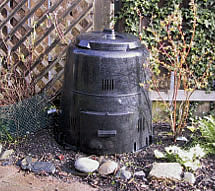 Unfortunately, most garden centers do not sell compost bins. Their prices simply cannot compete with the low prices offered through local governmental resources. Additionally, they are usually not a "big seller" compared to high-demand gardening tools. Similarly, garden centers rarely carry a Compost Aerator tool (for turning compost in a bin), but they usually have a box of compost activator in stock. Unfortunately, most garden centers do not sell compost bins. Their prices simply cannot compete with the low prices offered through local governmental resources. Additionally, they are usually not a "big seller" compared to high-demand gardening tools. Similarly, garden centers rarely carry a Compost Aerator tool (for turning compost in a bin), but they usually have a box of compost activator in stock.
THE BASICS OF A HOME COMPOSTING SYSTEM
Your choice of a compost bin or system is personal. One compost bin may be just the ticket. Experienced home composters may have learned over time that a multi-bin system is necessary to recycle regularly generated waste. Some people want something very efficient, perhaps just for food scraps. Others are satisfied with a homemade bin created from found resources, such as pallets or wire. Finally, there are those who enjoy composting more naturally, without compost bins.
All of these choices speak to a type of "system" that works to compost organic material. In the photos below, we present numerous types of bins/systems that you may choose at home. They are grouped according to type (wood, wire, commercial, etc.) with general comments and tips. Make sure you read what Professor Rot has to say, immediately below!
 Before Creating a System, ask . . . Before Creating a System, ask . . .
- How much waste do I throw away?
- Do I compost food scraps?
- Do I want my bin to be tidy and easy to get to?
- Will the bin be the right size for my needs?
- Is there room in my yard to increase the size of my system in the future? That is, add more bins or a stockpile bin?
- Does the bin have a lid and air vents? Can it keep rodents and pests out?
- Can I easily remove finished compost?
Plan Your System Around the
4 Rules of Composting
Right Ingredients
Air Circulation
Consisten Moisture
Adequate Volume |
MANUFACTURED COMPOST BINS
Millions of people have been introduced to composting by using manufactured bins. These are perfect for a One Bin or Multi-bin System.
In fact, most compost bins today are manufactured from high quality recycled plastic resin. These types of bins were introduced to the public in the mid-1990's. The manufacturers have been very competitive with each other to keep prices low. Best pricing has always been through local governmental sales.
The pictured bins are some of the most popular. These and many others are available on the internet or perhaps through your local waste management district.
Look for these features:
- portability
- lid and air vents
- scavenger resistance
- holds heat well
- adequate volume
- a bottom door to shovel out finished compost
- the option of a bottom pan (required by some municipalities)
You will need to stockpile ingredients near your bin, if desired.
The Issue of Volume
Researchers have determined that the ideal size of a compost bin should be about 3x3x3 feet (27 cubic feet), to ensure a large enough mass or volume for a pile to heat up.
Of course, the research assumes that one is creating a Batch Pile of compost all at once. While we encourage this for the homeowner (for hotter and faster finished compost), we also know for a fact that most people use the Add-as-You-Go method.
The point is, sometimes the Composting Rule of Adequate Volume does not work. That is the issue with manufactured bins: their volume is often significantly less than the "ideal" mass suggested by researchers.
Not to worry. You can still get very good compost in your manufactured bin if you use balanced ratios of GREENs and BROWNs, as well as follow the many instructions on this website.
Many people enjoy the pleasures, success and ease of backyard composting in their manufactured bin.
Turning the Compost
One of the issues with manufactured bins is ease of access to turning the organic material. It is difficult to do so with a shovel or garden fork. The compactness of the bin, and its height, makes it difficult to wedge a shovel or fork far enough into the top to pull the material up and around inside.
Great success and ease is yours by using a quality Compost Aerator tool, as shown and sold on this website.
Accessing Finished Compost
Many of these types of bins have a trapdoor at the bottom that allows access to the finished compost at the bottom of the pile.
Otherwise, shovel the compost out of the top opening. Better yet, rock the bin back and forth to loosen the compost inside, then pull the bin off and away to the side. Then you can shovel your compost as needed (cover with a tarp when not used), and start a new pile inside the empty bin nearby.
|
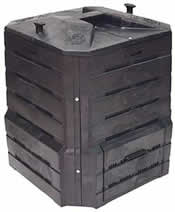
The Soilmaker |
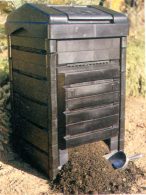
The Garden Gourmet |
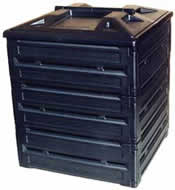
The Biostack |
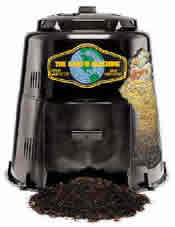
The Earthmachine |
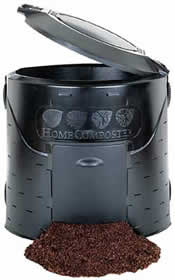
The Home Composter |
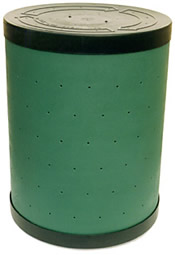
The Cascadia |
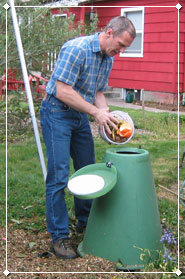
The Green Cone Composter
for food scraps |
COMPOST TUMBLERS
One of the fastest ways to make finished compost is by using a tumbler.
A good compost tumbler aerates, turns and heats the organic material very efficiently, creating finished compost in as little as 3 weeks!
Over the years, tumblers have come and gone repeatedly. The reasons are that they tend to be very expensive, the gears or "tumbling" mechanisms break down, or they disintegrate.
There are a variety of tumblers available, only a couple of which are shown here. Available almost exclusively on the internet.
The Issue of Volume
Tumblers are not able to compost large volumes of organic matter. Their size prohibits this because they would become incredibly unwieldy to turn! People who use tumblers must be committed to actively tumble the tumbler! Most often, however, users discover that a tumbler cannot keep up with the garden debris generated throughout the seasons, without needing to get a regular compost bin.
Nonetheless, it is true that a tumbler can make good compost fairly quickly.
The Issue of Turning
Perhaps the biggest issue for tumblers is the actual tumbling mechanism itself. This may break down over time.
Many people discover, however, that they may not be able to easily turn the tumbler full of material because of the weight of the volume. Being discouraged, they give up. Manufacturers are always coming up with better and easier mechanisms.
The Issue of Accessing Compost
All tumblers have trap doors to access compost, or to stuff material inside. Such access can really be an issue for some people trying to stick a shovel inside. Not all the contents tumble out so easily!
|
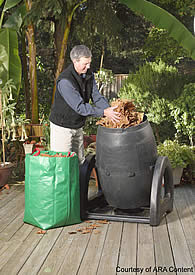 |
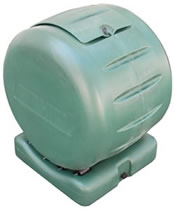 |
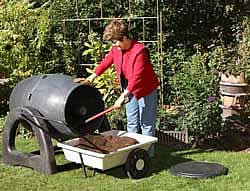 |
WIRE OR PLASTIC COLLECTOR
Inexpensive way to compost or use as a holding bin. Field fencing, rabbit wire, or manufactured plastic with holes (the Presto Hoop Companion, bottom right photo) is sturdy.
Pile heats slowly and may attract rodents and pests. Keep covered with a lid; when compost is finished, remove collector!
Most people tend to create their wire bin too large. They are then discouraged that they don't have enough waste material to fill it!
Wire bins, however, are great for stockpiling leaves, grass clippings, etc. for use in creating a Batch Pile. |
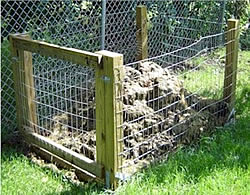 |
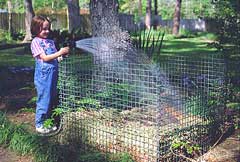 |
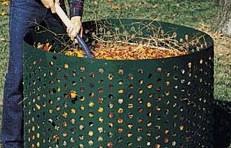
Presto Hoop Companion |
WOODEN BINS
Wooden bins can be creatively designed to the size you desire. The most important issues are:
- access to contents
- ability to retain heat
- scavenger resistance
- aesthetic appeal
- a top to close the pile
In the top two photos to the right, note that one would need to remove the boards from the top down, working your way around the bin, just to access the contents or to turn the pile, if using a shovel or garden fork.
These are nice looking bins, but their design may be flawed.
The lattice bin shown looks nice. The lattice panels on the front can be removed for access. The issue has to do with the large openings in the lattice for heat to escape or scavengers to access. Additionally, lattice can be fragile and easily broken over time.
The wooden bins in the lower right photo are solid and quite large. It does not appear they have front access.
When creating a wooden bin, use cedar: it can withstand moist conditions for many years before deteriorating. |
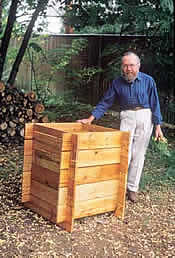 |
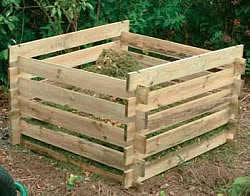 |
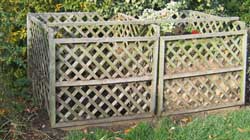 |
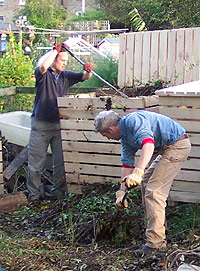 |
PALLET BINS
Absolutely the easiest bin to create with shipping pallets. Pallets come in all sizes and quality. Some have wide gaps in the wood span, while others may be nailed close together.
Pallet bins are excellent for stockpiling materials. They look a little more funky when used as a compost bin.
The two photos to the right demonstrate their use. Note a front access pallet panel that moves or slides away.
The pallets are easily joined/nailed at the corners to form a square.
Issues obviously relate to scavenger access, retaining heat, covering, and general access.
Pallets can also be used to create a multi-bin compost or stockpile system, as shown in the bottom photo. |
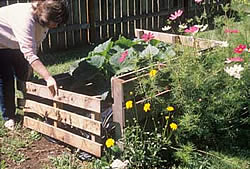 |
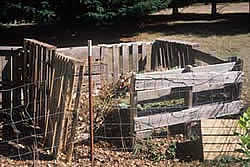 |
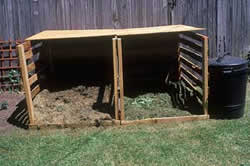 |
CREATIVE BINS
Who says you can't put your yard waste in a waste can?! Sometimes necessity is the mother of invention.
Whether you use a plastic barrrel or a metal trash can, use these guidelines:
- Have a lid to secure the top
- Drill holes in the sides for air ventilation
- Drill holes in bottom for leachate to seep out
- Monitor pile for proper moisture
- Locating bin in hot direct sun for many hours a day may actually heat the pile hotter than necessary! (We have one story in which a man saw the lid blow off his trash compost bin 10 feet into the air!)
The concrete block bin in the bottom photo is creative but problematic. For one, the blocks can easily dislodge; their height seems precarious! There is also the issue of holding heat, topping off with a lid or board, and keeping scavengers away. Best use is as a holding (stockpile) bin. |
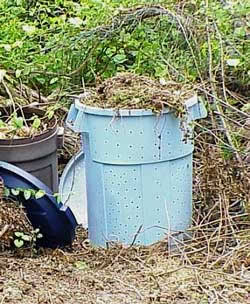 |
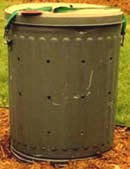 |
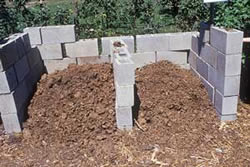 |
MULTI-BIN SYSTEMS
Many people who become seasoned backyard composters realize that 2-3 bins are perfect for handling year-round food and garden/yard waste.
The bins provide a rotation of compost that is both being made and completed.
In the top photo, the middle bin is actually a tumbler.
In the bottom photo, the front wooden boards slide up and off to allow access to varying depths of the pile in a particular bin stall. A sheet of plywood is the removable lid for each stall.
The 3-bin system shown was created in a few hours by the authors at their gardens. |
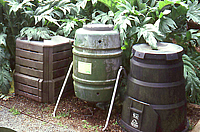 |
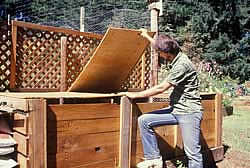 |
GOING NATURAL: ALTERNATIVE COMPOSTING METHODS
It is possible that not all your yard or kitchen waste can be recycled in a compost bin: you may have too much or your bin is already full and in use. Important alternatives (if allowed in your municipality) can be characterized as "natural systems": letting raw nature help out. These techniques especially increase worm life in your soil. That's good, real good!
Soil Incorporation
(Trench Composting)
The premise is simple: BURY your food waste (and yard waste), if allowed in your municipality.
Just dig a trench about 12-inches deep (30cm), throw in the items, chop and mix with soil, then cover with remaining soil. In a few months the rotted material will have been incorporated into the soil and you can plant above them.
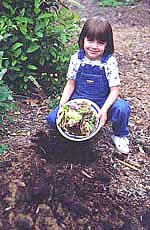
|
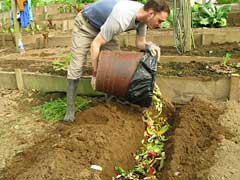 |
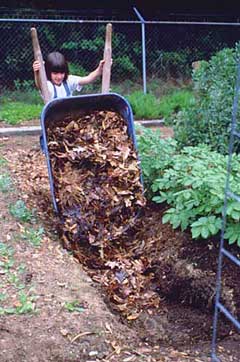 |
Raised-Bed Garden Integration
Similar to Soil Incorporation. Just dump the food scraps into the raised-bed and dig them into the soil deeply so that no scavengers can get to them.
In no time the worms will have digested every last bit of the food you wasted! |
 |
Sheet Composting
This mulching technique is useful for large amounts of leaves, yard clippings, etc. (No food wastes) Simply lay them down throughout the garden, or rototill them into the soil (late autumn is best or at least 2 months before planting time).
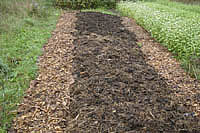
Mulching is critical in helping to retain soil moisture, and in erosion and/or weed control.
Worms also come to the surface at night to pull the mulch down into the soil.
|
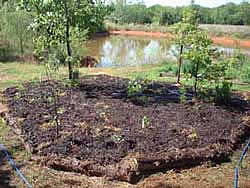
|
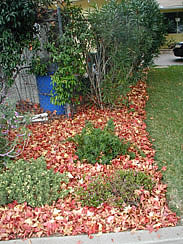 |
Grasscycling
Definitely a worthy alternative to composting grass clippings. To read more about this natural way to fertilize your lawn, see Grass Clippings. |
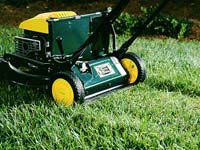 |
Covered Windrow
This heap-like pile is generally long, narrow, and high (up to 4-ft [1.2m] or higher). See the compost heap photo to the right.
It is very simply layered as waste materials come available and kept
covered with plastic (photo lower right). Decomposition occurs within its own time and speed but eventually happens.
If disposing of food scraps in this pile, make sure they are well-covered or buried within it. |
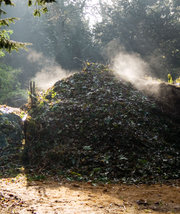
Photograph © Andrew Dunn, November 2005
Website: www.andrewdunnphoto.com
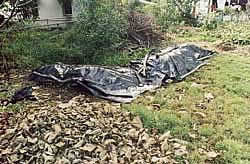
|
|



 Unfortunately, most garden centers do not sell compost bins. Their prices simply cannot compete with the low prices offered through local governmental resources. Additionally, they are usually not a "big seller" compared to high-demand gardening tools. Similarly, garden centers rarely carry a Compost Aerator tool (for turning compost in a bin), but they usually have a box of compost activator in stock.
Unfortunately, most garden centers do not sell compost bins. Their prices simply cannot compete with the low prices offered through local governmental resources. Additionally, they are usually not a "big seller" compared to high-demand gardening tools. Similarly, garden centers rarely carry a Compost Aerator tool (for turning compost in a bin), but they usually have a box of compost activator in stock.



































